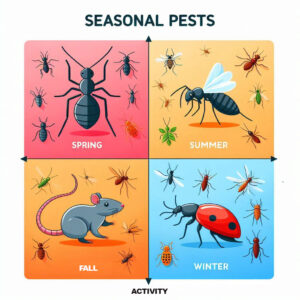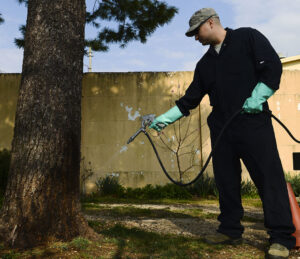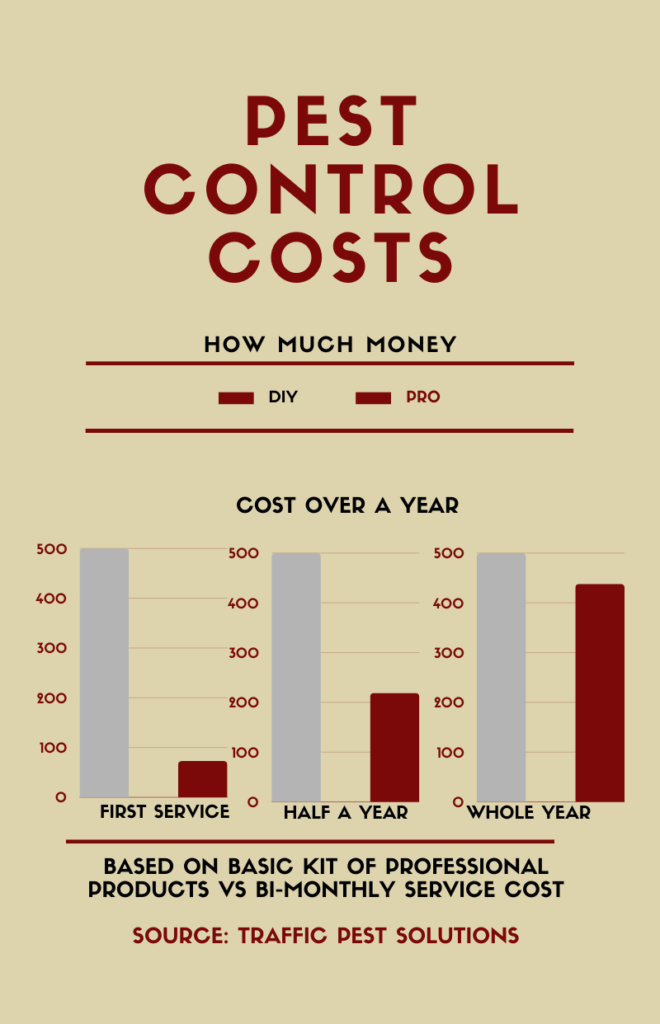Keeping your home pest-free can feel like a never-ending challenge, but with a proactive, year-round residential pest control plan and expert help, you can finally win the battle against unwanted pests. As a pest control technician with years of experience in residential pest control, I’ve seen how a consistent, preventive approach saves homeowners time, money, and provides much-needed peace of mind.
In this guide, I’ll walk you through the benefits of year-round pest control, what it entails, and share tips that you can do on your own to keep your home bug-free.
The Benefits of Year-Round Residential Pest Control
Every season has its own pest challenges, and keeping bugs and critters out is easiest when you stay ahead of the game. Here are some key benefits to a consistent pest control plan:
Consistent Protection Against Seasonal Pests

These are the pests I have noticed for each season. In spring, ants and termites wake up from the winter and start looking for food and shelter. By summer, flies and mosquitoes are in full swing, taking advantage of the warm weather. Fall is when rodents and spiders start moving indoors to escape the cold, and in winter, year round pests like cockroaches and certain insects sneak in to stay warm, joining the rodents.
If you’re only calling for pest control once a year (or just when you see bugs), you’re essentially playing a game of catch-up. A year-round plan allows professionals to target each pest when it’s most active, keeping infestations under control before they even start.
Preventative Maintenance Saves Money
One of my clients had a serious ant problem, which started as a small issue in the spring. By the time they called us mid-summer, the ants had already established colonies inside their walls. A quick preventive treatment earlier in the year could have prevented a costly infestation. Regular service during the cooler months is when we gain the most ground treating and checkups help detect issues early on, saving money on major treatments and repairs.
Targeted Treatments Mean Fewer Chemicals

Many people worry about chemicals in pest control, but expert treatments are safe, eco-friendly, and tailored to your home’s needs. Most products used are in the “CAUTION” category or even safer tiers. Rather than a one-size-fits-all solution, we focus treatments exactly where needed, reducing the overall amount of chemicals applied. This targeted approach is not only effective but also safer for kids and pets.
The Top Pests to Watch Out for in Each Season
Let’s take a closer look at what you’ll be dealing with throughout the year.
Spring: Ants, Termites, and Wasps
With warming temperatures, ants start forming food trails, termites look for new colony sites, and wasps emerge to build nests in attics or outdoor structures. Gophers and other rodents also start breeding this time of year. Early treatment is key in spring to prevent these pests from multiplying.
Summer: Flies, Mosquitoes, and Stinging Insects
Flies and mosquitoes thrive in the summer heat, along with stinging insects like bees, wasps, and hornets. This season is ideal for outdoor pest control to reduce insect populations, especially if you’re enjoying more time outside. Just remember that chemical treatments are less effective in intense sunlight due to UV exposure, so more frequent treatments may be necessary.
Fall: Rodents and Spiders
As temperatures drop, rodents and spiders begin seeking shelter indoors. This is the ideal time to inspect your home for entry points like gaps and cracks, preventing critters from sneaking inside. Common trouble spots include areas where the AC line enters the home and worn garage door weather stripping.
Winter: Cockroaches and Overwintering Pests
During winter, pests like cockroaches, ants, and certain beetles find warmth inside basements, bathrooms, and kitchens. Routine treatments prevent them from settling in. In Southern California, winter rains can flood rodent burrows, often driving them indoors in search of drier shelter.
What an Expert Year-Round Residential Pest Control Program Includes
So, what can you expect from a year-round residential pest control program? Here’s a breakdown of what working with an experienced technician involves.
Home Inspection and Assessment
Every effective pest control plan begins with a thorough inspection. We focus on areas where pests are most likely to enter—doors, windows, pipes, attics, and basements. Often, I find entry points that most homeowners miss, like cracks in the foundation, rat grease marks along walls, or gaps under doors.
Customized Treatment Plan
Based on our inspection, we develop a treatment plan tailored to your home and specific pest issues. For instance, if ants are a recurring spring problem, we might start with a product like Taurus SC, which is highly effective against ants, and then switch to a spider-targeting treatment like Bifenthrin in the fall.
Ongoing Monitoring and Adjustments
Pest patterns can change, and a plan that worked well last year may need tweaking this year. Regular follow-ups let us track progress, identify new issues, and adjust as necessary. It’s like a seasonal “pest check-up” to ensure we’re staying ahead of potential problems. I often see similar patterns in homes each year, but there’s always a bit of variation.
DIY Tips to Complement Professional Pest Control

In addition to professional treatments, here are a few DIY steps that can help keep pests away:
Seal Cracks & Crevices
Sealing up small cracks and crevices where pests enter can make a big difference. For example, I had a client who was constantly dealing with small flies in the kitchen. I’d treat the area and even clean his sink drain occasionally, but I also noticed water was getting into cracks in his counters. After years of this back-and-forth, he finally sealed the counter cracks, and the flies never returned.
Proper Food Storage
Pests are attracted to food sources, so keeping your kitchen tidy and food properly stored is essential. I advise clients to sweep up crumbs, store dry goods in airtight containers, and regularly take out the trash. This not only helps prevent pantry pests like Indian meal moths and grain beetles but also deters ants and rodents from invading and contaminating food.
Yard Maintenance
Overgrown yards and standing water are magnets for pests. Keeping the grass trimmed, clearing leaves (rodents love hiding in dense brush), and eliminating standing water can all help reduce pest pressure around your home. It’s also smart to cut back any overgrown trees or branches touching your house—ants can use them as pathways, and larger trees often bring spiders in from above, especially if you have old oaks.
Understanding the Costs and Value of Year-Round Residential Pest Control
Pest control is an investment, not just an expense. Here’s why:
Investment vs. Expense

One common question I hear is, “Is it really worth it?”—often from someone saying they could handle it themselves. But doing pest control effectively requires regular intervals, specific timing, and high-quality products. To buy the same quality from a store, you’d likely spend as much as hiring a professional, without the benefits of expert application and follow-up. Proactive pest control saves you from headaches and potential property damage.
Transparent Pricing and Service Frequency
Most pest control plans offer flexible options—monthly, quarterly, or yearly—making it easy to find one that fits your budget. Even the most basic plan provides an effective line of defense, preventing small problems from becoming big ones.
Long-Term Health and Safety
Pests bring more than inconvenience; they can impact your health. Cockroaches, for instance, trigger allergies and asthma, while rodents carry harmful bacteria. I have a colleague who suffered a stroke from bacteria found in rodent droppings. Professional pest control helps minimize these risks, maintaining a safer, healthier home.
Choosing the Right Pest Control Company
Picking the right company can make all the difference. Here’s what to look for:
What to Look for in a Residential Pest Control Service
Choose a company that’s licensed, certified, and experienced in residential pest control. Check online reviews, ask for referrals from friends or family, and talk directly with the company to ensure they’re knowledgeable and professional.
Questions to Ask Before Hiring

Ask about their treatment methods, guarantees, and eco-friendly options. Make sure they offer flexible scheduling and have a responsive customer service team in case issues arise between treatments. Important questions include: Will I have a set service day, like the second Tuesday of each month? Do you offer reminders? How is billing managed—are there late fees if payment is delayed due to mail?
Why a Local Expert Makes a Difference
Local pest control companies understand the specific pests and conditions in your area. They know when seasonal pests are likely to be active and what preventive measures work best in your environment.
Preventing Future Infestations: Tips for a Pest-Free Home Year-Round
Here’s how to keep things pest-free between visits:

Consistent Home Hygiene
A regular cleaning routine, like sweeping floors and wiping down counters, goes a long way toward keeping pests out. While it may not eliminate every issue, it helps prevent many pest problems from getting started.
Seasonal Pest-Proofing Checklist
At the start of each season, go through a simple checklist to reinforce your home’s defenses. For example, in the fall, focus on sealing gaps and setting up traps for rodents; in summer, focus on removing standing water and using insect repellents when outdoors.
Engaging with Your Pest Control Provider
Communication is key. If you notice pest activity between treatments, let your provider know so they can adjust accordingly. Being proactive keeps small issues from becoming bigger problems. Your technician should also check in upon arrival, allowing you to bring up any concerns.
Conclusion
Year-round pest control is about consistency and prevention. By working with an experienced technician, you can keep your home pest-free, saving yourself time, money, and stress in the long run. If you’re ready to start a year-round pest control program, reach out for an evaluation—you’ll be glad you did. Let’s make your home a bug-free zone all year long!

